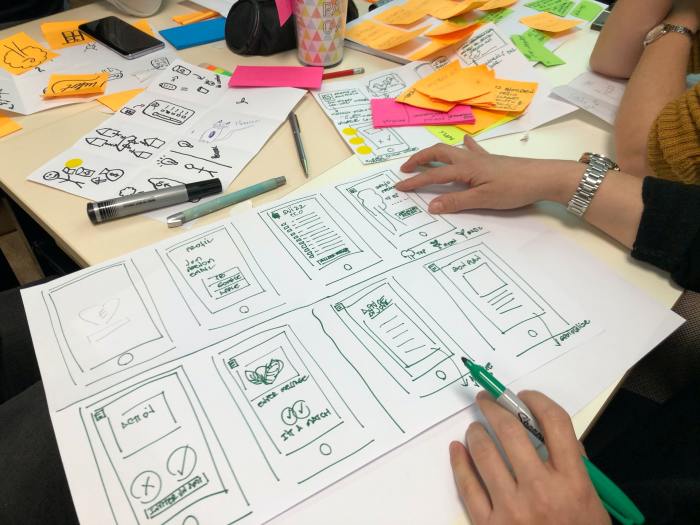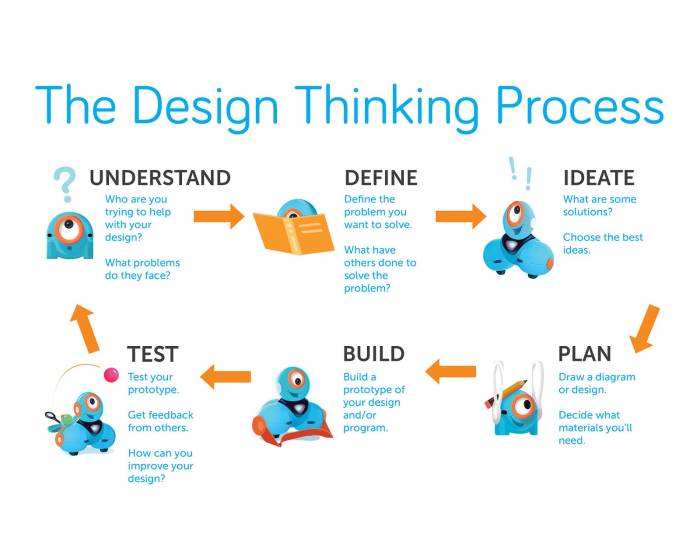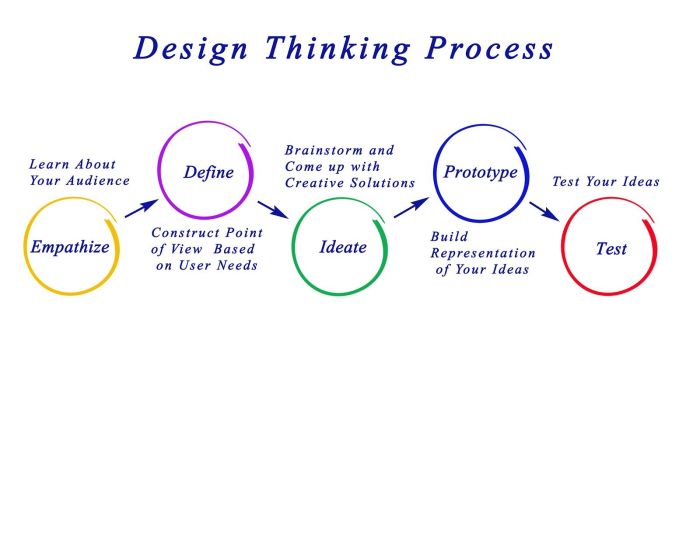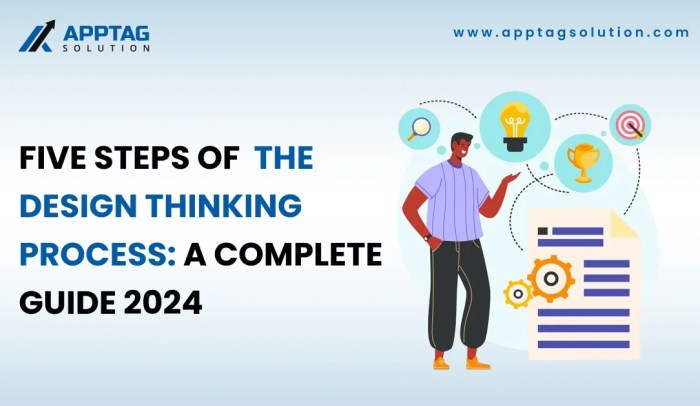Designing a successful design thinking challenge requires careful planning and execution. This process, often overlooked, is crucial for fostering innovation and generating valuable insights. By following a structured approach, you can create a challenge that effectively engages participants, encourages creative problem-solving, and delivers meaningful results. This guide Artikels a six-step framework to help you build a compelling and impactful design thinking challenge.
The six steps encompass defining the challenge and its target audience, meticulously structuring the challenge process, and finally, implementing and rigorously evaluating the results. Each stage demands careful consideration, from crafting compelling narratives to developing robust evaluation metrics. Through this structured approach, you can transform a simple challenge into a powerful tool for driving innovation and strategic decision-making.
Defining the Challenge & Audience

Clearly defining the challenge and identifying the target audience are crucial first steps in a successful design thinking process. A well-defined challenge provides focus and direction, while understanding the audience ensures solutions are relevant and impactful. This section will Artikel the process of defining a design thinking challenge, focusing on the ideal user profile and the problem it addresses.
The ideal user profile for this design thinking challenge is a multifaceted individual. We’re targeting individuals aged 25-45, predominantly professionals working in creative fields or those who value innovative solutions in their daily lives. They are digitally savvy, comfortable using technology, and actively seek out improvements in their workflow or daily routines. They are also likely to be early adopters of new technologies and methods, open to feedback and collaborative problem-solving.
The Problem and Opportunity
This design thinking challenge aims to address the pervasive issue of inefficient project management within small creative teams. Many small creative businesses struggle with disorganization, missed deadlines, and unclear communication, leading to decreased productivity and increased stress. The opportunity lies in developing a streamlined, user-friendly system that improves collaboration, enhances communication, and ultimately boosts the efficiency and success rate of creative projects. This system should not only improve project management but also foster a more collaborative and creative work environment. The challenge is to design a solution that addresses these problems and improves overall project success.
The Challenge’s Narrative
Imagine a small graphic design studio struggling to meet tight deadlines. Emails are overflowing, project files are scattered across multiple platforms, and team members are constantly chasing updates. Frustration mounts, creativity suffers, and projects are delivered late or below expectations. This is a common scenario for many small creative teams, and it represents a significant problem that impacts productivity, profitability, and overall morale. This challenge aims to transform this chaotic reality into a streamlined, collaborative workflow where projects are completed efficiently, on time, and to the highest standards. By solving this problem, we can significantly improve the working lives of creative professionals and help their businesses thrive.
User Personas
To further refine our understanding of the target audience, we’ve developed three distinct user personas:
Persona 1: The Busy Entrepreneur – Sarah is a 35-year-old freelance graphic designer running her own small business. She juggles multiple projects simultaneously, often feeling overwhelmed by administrative tasks. This challenge will help Sarah streamline her workflow, freeing up time to focus on her creative work and improving her business efficiency.
Persona 2: The Team Lead – Mark is a 40-year-old art director leading a team of five designers. He struggles to keep everyone on track and ensure clear communication across the team. This challenge will provide Mark with tools to improve team collaboration, track progress effectively, and ultimately deliver projects on time and within budget.
Persona 3: The Junior Designer – Alex is a 26-year-old junior designer who feels lost in the chaos of a busy studio environment. He struggles to find the information he needs and often feels unsure about his role in larger projects. This challenge will help Alex navigate the project workflow more effectively, improve his organizational skills, and increase his overall confidence.
Challenge Objective Statement
Design a user-friendly project management system for small creative teams that improves collaboration, streamlines workflows, and enhances overall project efficiency.
Structuring the Challenge Process

Effective structuring is crucial for a successful design thinking challenge. A well-defined process ensures participants remain focused, understand their roles, and contribute meaningfully to the final solution. This section Artikels key elements for organizing your challenge, from creating a timeline to establishing evaluation criteria.
A structured approach ensures the challenge progresses smoothly, maximizing participant engagement and delivering valuable insights. Clear timelines, well-defined roles, and consistent communication are essential components of a successful design thinking process.
Challenge Timeline
A detailed timeline provides a roadmap for the challenge, outlining key milestones and deadlines for each stage. This allows participants to manage their time effectively and ensures the project stays on track. Consider the length of your challenge and allocate sufficient time for each step, including buffer time for unforeseen delays.
| Stage | Duration (Example) | Activities | Deliverables |
|---|---|---|---|
| Empathize | 2 days | User research, interviews, observation | User personas, empathy maps |
| Define | 1 day | Problem statement refinement, challenge framing | Clearly defined problem statement, challenge brief |
| Ideate | 2 days | Brainstorming sessions, idea generation, sketching | List of potential solutions, concept sketches |
| Prototype | 3 days | Rapid prototyping, testing, iteration | Functional prototype, user feedback |
| Test | 2 days | User testing, feedback collection, analysis | Test results, revised prototype |
| Iterate | 1 day | Refine solution based on feedback, final presentation preparation | Final presentation, refined solution |
Challenge Flowchart
A visual representation of the challenge process aids understanding and improves communication. The flowchart below, presented as a table for responsiveness, guides participants through each stage. Each box represents a step, with arrows indicating the flow of the process. This visual aid serves as a quick reference throughout the challenge.
| Empathize | Define | Ideate | Prototype |
| → | |||
| Test | Iterate | ||
Essential Resources
Providing participants with the necessary resources ensures a smooth and efficient process. This includes tools, software, and materials needed for each stage. Access to these resources eliminates potential bottlenecks and allows participants to focus on the challenge.
Here’s a sample list of resources categorized by stage:
- Empathize: Interview guides, observation checklists, notepads, recording devices.
- Define: Whiteboards, sticky notes, markers.
- Ideate: Brainstorming templates, sketching materials, mind-mapping software.
- Prototype: Prototyping tools (e.g., cardboard, software), craft supplies.
- Test: User testing scripts, feedback forms, observation checklists.
- Iterate: Design software, presentation software.
Facilitating Brainstorming Sessions
Effective brainstorming requires a structured approach to maximize creativity and collaboration. The facilitator plays a key role in guiding the session, ensuring all participants contribute and ideas are captured effectively. A positive and inclusive environment is crucial for fostering creative thinking.
A step-by-step procedure for facilitating group brainstorming sessions:
- Set the Stage: Clearly define the objective, establish ground rules (e.g., no judgment, build on ideas), and ensure a comfortable environment.
- Generate Ideas: Use brainstorming techniques (e.g., brainwriting, round robin) to encourage diverse contributions.
- Organize and Categorize: Group similar ideas, identify themes, and prioritize based on feasibility and impact.
- Visualize Ideas: Use visual aids (e.g., mind maps, diagrams) to represent and organize the generated ideas.
- Document and Share: Capture all ideas, ensuring clarity and accessibility for all participants.
Participant Performance Rubric
A rubric provides a standardized way to evaluate participant performance at each stage. This ensures consistent assessment and allows for fair comparison across participants. The rubric should be clear, concise, and aligned with the learning objectives of the challenge.
Example Rubric Criteria:
- Empathy: Demonstrates understanding of user needs and perspectives.
- Problem Definition: Clearly articulates the problem and its scope.
- Ideation: Generates creative and relevant solutions.
- Prototyping: Develops functional and user-friendly prototypes.
- Testing: Conducts thorough user testing and analyzes results effectively.
- Iteration: Incorporates feedback and refines the solution.
Implementing & Evaluating the Challenge

Successfully implementing and evaluating a design thinking challenge requires a structured approach that prioritizes participant engagement, iterative feedback, and measurable outcomes. This section Artikels key strategies for ensuring a productive and insightful challenge experience.
Effective implementation hinges on careful planning and execution across several key areas. From onboarding participants to analyzing feedback, each step contributes to the overall success of the challenge. A well-defined process ensures the challenge remains focused and yields valuable results.
Participant Onboarding and Engagement
A comprehensive onboarding process is crucial for setting the stage for a successful challenge. Participants need clear instructions, context, and resources to feel confident and engaged. This includes providing a detailed challenge brief outlining the problem, goals, timeline, and expectations. A well-structured welcome session, perhaps incorporating an icebreaker activity to foster camaraderie, can also significantly improve engagement. Regular communication throughout the challenge, using platforms like Slack or Microsoft Teams, helps keep participants informed and motivated. Providing access to relevant resources, such as design thinking toolkits or example case studies, further enhances the experience. Finally, ensuring accessibility for participants with varying levels of experience and technical proficiency is crucial for inclusivity and broad participation.
Gathering and Analyzing Participant Feedback
Collecting and analyzing participant feedback is essential for iterative improvement and measuring the effectiveness of the challenge. Multiple methods can be employed, including surveys (both pre and post-challenge), informal feedback sessions, and observation of participant interactions during the challenge. Quantitative data, such as the number of ideas generated or the level of participant satisfaction, can be analyzed to understand overall success. Qualitative data, gathered through open-ended questions or observation notes, can provide deeper insights into the process and the participants’ experiences. Analyzing this data can reveal areas for improvement in the challenge design, facilitation techniques, or resource provision. Regular feedback loops throughout the challenge allow for adjustments and course correction, ensuring the process remains dynamic and responsive.
Fostering Collaboration and Creativity
Encouraging collaboration and creativity within the challenge requires a carefully designed environment. Using collaborative tools such as online whiteboards or shared documents can facilitate idea generation and brainstorming. Structured activities, like design sprints or brainstorming sessions with specific prompts, can help focus the participants’ efforts and generate a diverse range of ideas. Creating a safe and inclusive environment where participants feel comfortable sharing ideas and providing constructive feedback is crucial. This can be achieved by establishing clear guidelines for respectful communication and by actively encouraging participation from all members of the team. Facilitators can play a key role in guiding the process, ensuring that all voices are heard and that the discussion remains productive and focused.
Iterative Feedback Loops
Incorporating iterative feedback loops is critical for continuous improvement throughout the challenge. Regular check-ins with participants allow for early identification of challenges and opportunities for improvement. This can involve brief surveys, informal feedback sessions, or even quick polls to gauge participant sentiment and identify any roadblocks. The feedback gathered should be promptly analyzed and used to make adjustments to the challenge process, timeline, or resources. These iterative cycles ensure the challenge remains relevant, engaging, and responsive to the evolving needs and insights of the participants. This iterative approach ensures that the final solutions are well-refined and address the core problem effectively.
Measuring Challenge Success
Measuring the success of the challenge requires pre-defined metrics that align with the challenge’s goals. These metrics should be both qualitative and quantitative. Quantitative metrics might include the number of innovative solutions generated, the level of participant engagement, or the number of prototypes created. Qualitative metrics could focus on participant satisfaction, the perceived value of the challenge, or the impact of the solutions on the defined problem. These metrics should be tracked throughout the challenge and analyzed post-challenge to assess overall effectiveness. A comprehensive report summarizing the findings and recommendations, including areas for improvement in future iterations, should be produced. This data will inform future design thinking challenges and improve the overall effectiveness of this approach within the organization.
Last Recap

Successfully designing a design thinking challenge hinges on a well-defined process that prioritizes clear communication, robust structure, and thorough evaluation. By following the six steps Artikeld, you can create a challenge that not only stimulates creative problem-solving but also delivers actionable insights and fosters a culture of innovation. Remember, the iterative nature of design thinking should be reflected in your challenge design, ensuring continuous feedback loops and opportunities for refinement. The ultimate success lies in the challenge’s ability to drive meaningful change and achieve its intended objectives.